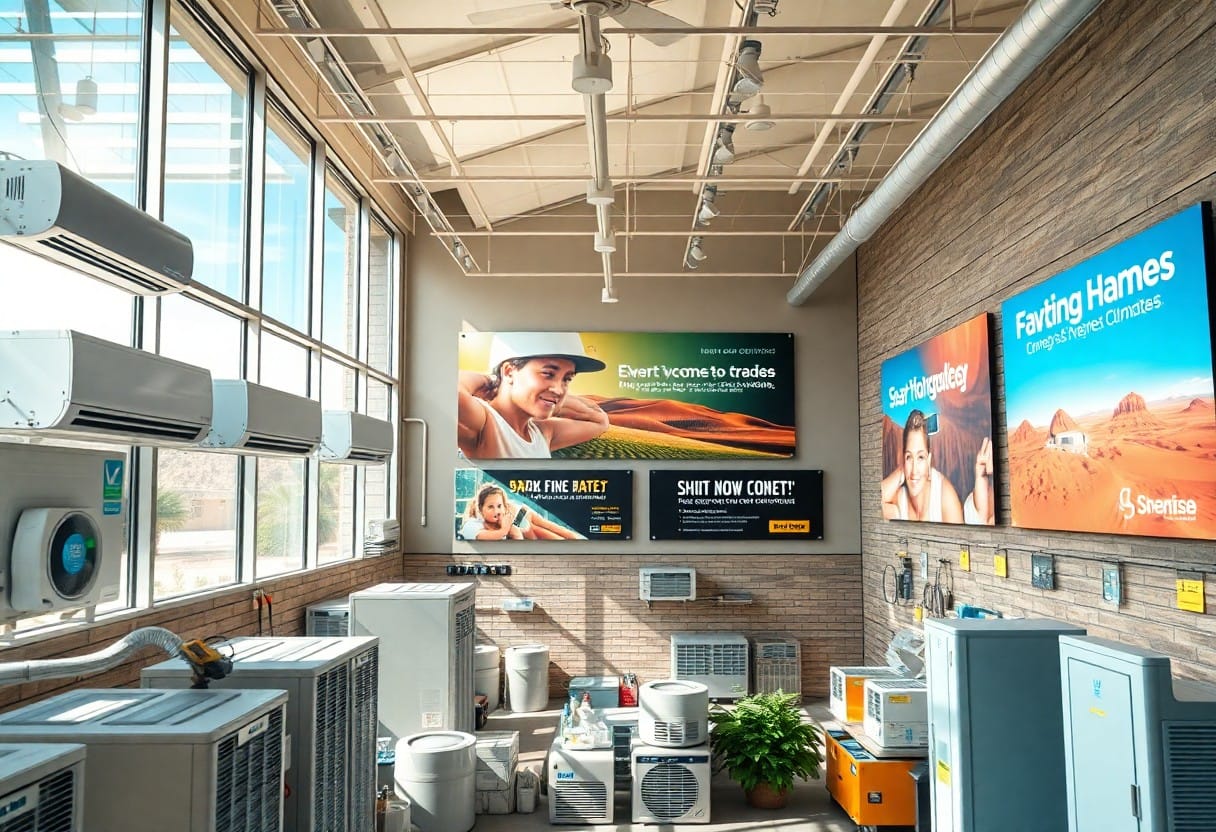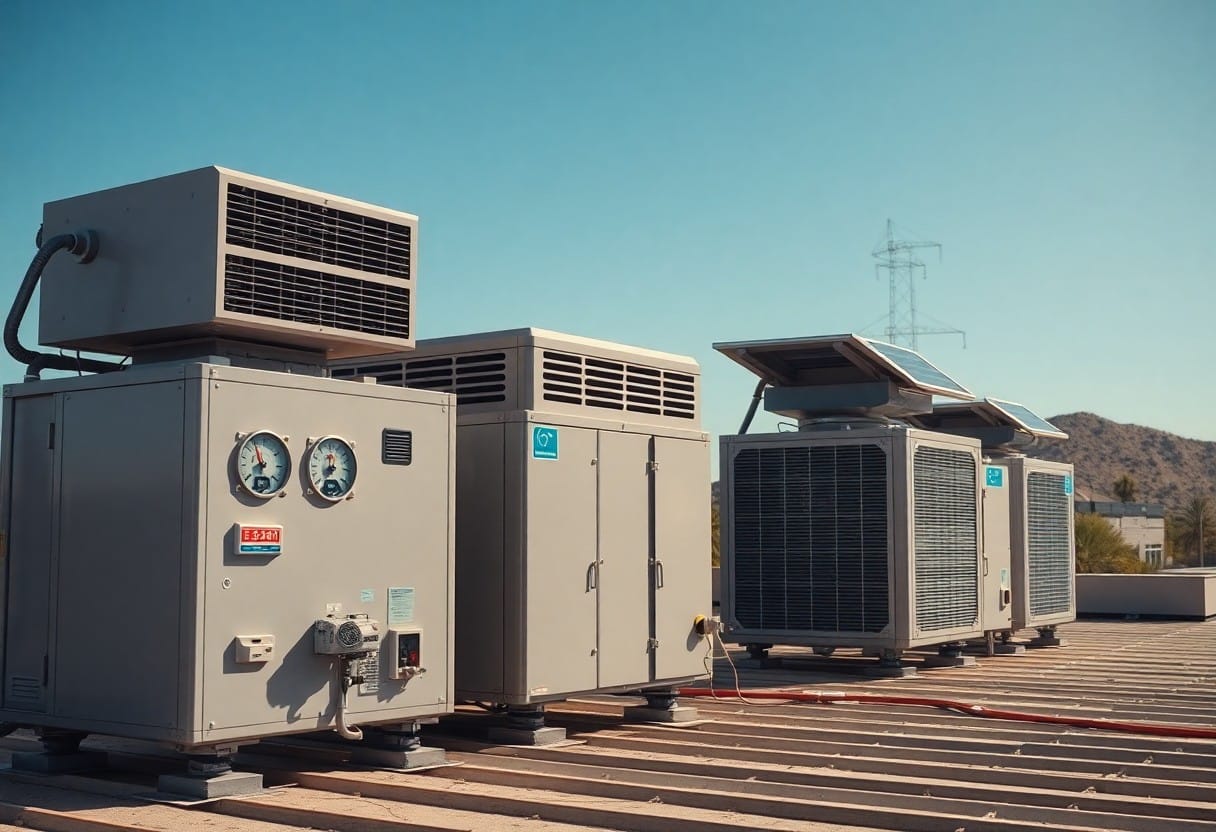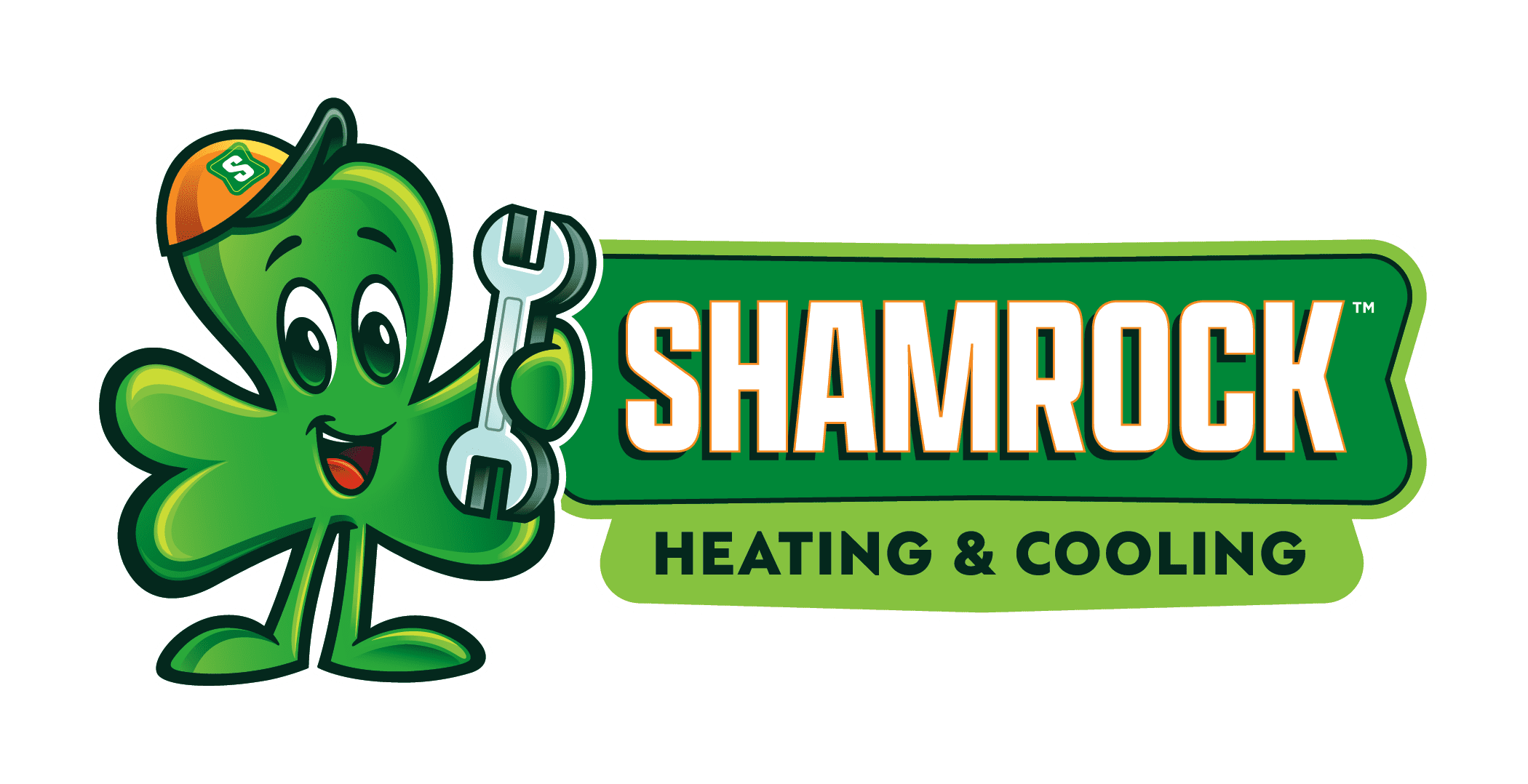With the ever-increasing temperatures in the Phoenix Metro area, you need to stay informed about emerging HVAC technology and energy-efficient solutions in 2025. As climate challenges compound, your choice of HVAC systems will significantly impact both your comfort and energy bills. This post highlights the latest trends, from smart thermostats to sustainable cooling methods, allowing you to make an informed decision for your home or business. Embrace these innovations to ensure optimal climate control and reduced environmental impact in the desert.

Overview of Phoenix Metro HVAC Landscape
Current Market Analysis
In 2025, the Phoenix Metro HVAC market is poised for significant growth, driven by the increasing demand for energy-efficient systems. With average summer temperatures soaring above 100°F, property owners prioritize cooling solutions that not only provide comfort but also reduce utility costs. In 2023, energy-efficient systems accounted for over 50% of all HVAC unit sales in the region, reflecting a clear shift toward sustainability and cost-effectiveness. You can expect this trend to accelerate, fueled by consumer awareness and local regulations promoting green technologies.
The >market has also seen a rise in smart HVAC technologies that integrate with home automation systems. The implementation of mobile apps allows you to adjust your home’s climate remotely, offering greater control over your energy usage. This technological integration is estimated to increase operational efficiency by 30%, further driving consumer interest in modern HVAC solutions.
Key Players and Innovations
Industry leaders like Trane, Carrier, and Lennox dominate the Phoenix HVAC landscape, continually investing in R&D to innovate their offerings. Trane’s latest model features variable-speed compressors, which adjust to outdoor conditions, ensuring optimal efficiency. Carrier’s use of eco-friendly refrigerants aligns with state regulations and consumer preferences for sustainable products. In addition, companies like Goodman’s are focusing on affordability without compromising quality, making advanced systems accessible to average homeowners.
Emerging players are also making waves in the market by introducing IoT-enabled units that monitor performance in real time. These innovations provide valuable data that allows technicians to conduct predictive maintenance, reducing unexpected breakdowns and costs for you. Startups are combining technology with user-friendly interfaces, ensuring you can easily manage your HVAC systems from any location.

Climate Change Impact on HVAC Systems
Rising Temperatures and Humidity Levels
As climate change progresses, the Phoenix Metro area will likely experience an increase in average temperatures, with predictions suggesting annual highs could exceed 120°F by 2025. This shift will demand innovative HVAC solutions to cope with unprecedented heat. The need for systems designed to handle extremes becomes paramount, as standard units may struggle or even fail under stress. High performance and energy efficiency will not just be preferences; they will be necessities.
In addition to rising temperatures, increases in humidity levels pose a significant challenge for your HVAC systems. More moisture in the air can lead to decreased indoor air quality and discomfort. Studies predict that humidity levels could rise by as much as 30% in some areas, making it crucial for your HVAC to incorporate advanced dehumidifying capabilities. Keeping your home comfortable will require solutions that blend cooling and humidity control in a seamless manner.
Projected Changes in Climate and HVAC Requirements
| Factor | Impact on HVAC Systems |
| Increasing Temperatures | Higher cooling demands, potential for equipment failure |
| Rising Humidity | Need for advanced dehumidification solutions |
Adapting Technology for Extreme Conditions
Future HVAC systems will integrate advanced technologies to withstand the challenges posed by climate change. Enhanced materials and smart technology will enable units to operate efficiently, even during the hottest months. For instance, variable refrigerant flow technology allows for precise temperature control and energy savings, responding to changes in real-time based on external conditions.
Moreover, automated systems equipped with predictive analytics will help homeowners manage energy consumption effectively. These innovations ensure your HVAC system isn’t just reactive but anticipates weather patterns, optimizing performance without sacrificing comfort. Consider incorporating zones in your home, allowing for tailored climate control that addresses specific needs while conserving energy.
Energy Efficiency Trends
Smart Thermostats and IoT Integration
Smart thermostats are becoming integral to enhancing energy efficiency in HVAC systems. These devices enable you to gain greater control over your heating and cooling by learning your preferences and adjusting settings accordingly. For instance, models that connect to your smartphone allow you to adjust your home’s temperature remotely, ensuring energy is not wasted when you’re away. According to industry reports, homes equipped with smart thermostats can see energy savings of up to 20% annually, which can significantly reduce your utility bills.
In 2025, expect the integration of Internet of Things (IoT) technologies to become more sophisticated. HVAC systems will communicate with other smart home devices, monitoring usage patterns and environmental conditions. This interconnectedness ensures your systems operate at optimal efficiency, further lowering your energy consumption. The ongoing evolution of these technologies makes it imperative to stay informed about Future HVAC Trends in 2025 Every Homeowner Should consider.
Renewable Energy Sources in HVAC
Utilizing renewable energy sources is transforming how HVAC systems operate, particularly in the Phoenix Metro area. With abundant sunshine, solar energy is paving the way for homeowners to power their HVAC systems sustainably. Solar installations can reduce reliance on traditional power sources, offsetting energy costs and minimizing environmental impact. Focusing on hybrid systems that combine renewable sources with conventional HVAC units can enhance overall efficiency, providing flexibility and reliability in energy use.
In 2025, the push for renewable energy-powered HVAC solutions will lead to increased governmental incentives and rebates for homeowners. Innovations in technologies, like solar thermal systems for heating and cooling, will make these solutions more accessible and affordable. By tapping into renewable energy, you not only cut down on your utility costs but also contribute to a healthier environment.
Sustainable Practices in HVAC
Your HVAC systems in the Phoenix Metro area are increasingly leaning towards sustainability, echoing a wider global movement towards environmentally friendly practices. A major component of this trend involves utilizing eco-friendly refrigerants that minimize ozone depletion and global warming potential. With an emphasis on alternatives such as R-32 and HFOs (hydrofluoroolefins), the industry targets lower emissions without sacrificing efficiency. In fact, switching to these refrigerants can also enhance your system’s performance while keeping energy use in check, translating to both environmental benefits and economic savings.
Eco-Friendly Refrigerants
The phasedown of HCFCs (hydrochlorofluorocarbons) has set the stage for a significant shift in refrigeration technology. As federal regulations tighten, HVAC manufacturers are innovating to develop refrigerants with lower global warming potential. You’ll notice that products labeled with “low-GWP” certifications are becoming the norm, ensuring you select options designed to be less harmful to the environment. Such advancements not only align with regulatory trends but also cater to the growing consumer demand for sustainable solutions.
Water Conservation Techniques
In a desert environment, implementing water conservation techniques is vital for sustainable HVAC operations. Systems equipped with advanced cooling technologies, such as evaporative coolers or water-efficient chillers, can significantly reduce your water usage while maintaining optimal indoor climate control. By embracing these technologies, you contribute to resource sustainability while also potentially lowering your utility bills.
Moreover, consider integrating smart irrigation systems that can work in tandem with your HVAC units. Some modern systems monitor local weather conditions and moisture levels, adjusting water usage accordingly. Implementing such systems could lead to a reduction of up to 30% in water consumption, a substantial figure in a region where every drop counts. By adopting these practices, you ensure that your HVAC systems are both efficient and environmentally responsible.
Consumer Preferences and Behaviors
Your choices in HVAC systems are heavily influenced by evolving consumer preferences and behaviors, particularly in the unique climate of the Phoenix Metro area. According to an analysis of HVAC industry trends, there’s growing demand for systems that prioritize both energy efficiency and sustainability. Many consumers are increasingly seeking eco-friendly options that reduce their carbon footprint while effectively managing indoor climate control, reflecting a significant shift in market expectations.
Trends in HVAC System Purchases
The increasing reliance on smart technology in HVAC systems is shaping purchase decisions, as you benefit from features that enhance control and efficiency. Many buyers are investing in systems equipped with AI algorithms that optimize energy usage and predict maintenance needs. Additionally, you may notice a trend toward multi-zone systems that allow for customizable temperatures in different areas of your home, providing comfort tailored to your lifestyle.
Shifts in Maintenance and Service Expectations
As you consider your HVAC needs, the emphasis on predictive maintenance has gained traction. Consumers expect service providers to utilize data-driven insights to anticipate issues before they escalate. This shift reflects a desire for minimal disruption and maximized system longevity, prompting manufacturers and service technicians to adopt new technologies that enhance the overall customer service experience.
The greater availability of online reviews and instant feedback mechanisms means you have more influence over the services you choose. Social media platforms and review sites serve as crucial resources for making informed decisions about HVAC service providers, as you rely on peer recommendations and shared experiences. This wave of transparency encourages companies to enhance their services continuously, ensuring they meet your evolving expectations for maintenance and response times.
Regulatory Changes and Standards
Energy Codes and Compliance
Your HVAC systems must adapt to the evolving energy codes that govern efficiency and performance standards. In Arizona, the latest modifications to the energy codes require installations to meet higher SEER (Seasonal Energy Efficiency Ratio) ratings, pushing the minimum for new air conditioning units to around 14 SEER. Failing to comply with these codes can result in financial penalties and increase your operational costs through inefficient energy use. Compliance not only affects legality but also helps you achieve potential savings on energy bills as more efficient systems consume less power, significantly reducing your energy footprint.
In addition to SEER ratings, new regulations emphasize proper insulation and duct sealing as pivotal components of HVAC efficiency. You’ll find that adhering to these standards requires professional assessments to ensure that your systems are optimized for the demanding Phoenix climate. The cost of retrofitting non-compliant systems may seem daunting, yet the long-term benefits—like reduced energy consumption and increased system longevity—often outweigh the initial investment.
Future Legislation Impacting HVAC
Upcoming legislation continues to reshape the HVAC landscape, with a focus on sustainability and innovation. You may soon see policies encouraging the adoption of advanced technologies such as smart HVAC systems that use AI to optimize performance based on real-time data. As these technologies become standard, staying ahead of the legislative curve will not only improve your compliance but also enhance your operational efficiency, thereby driving down costs and boosting your competitive edge in the market.
As legislation shifts, local jurisdictions might adopt unique guidelines to address specific climate challenges. For instance, initiatives could emerge that promote alternative refrigerants to minimize environmental impact, which means you’re likely to need training or resources to implement these changes effectively within your operations. This proactive adaptation to future legislation is important for maintaining your reputation as a responsible provider in the HVAC sector.
New laws are expected to focus on refrigerant management, with restrictions on high-GWP (Global Warming Potential) substances. These regulations may require you to transition to more eco-friendly alternatives, which not only aligns with current sustainability trends but also positions you as a leader in compliance and environmental stewardship in the HVAC industry.
To Wrap Up
From above, it’s evident that the future of HVAC systems in the Phoenix Metro area will be shaped by innovative technologies and a focus on energy efficiency. As you consider your options for climate control, investing in smart thermostats and advanced filtration systems will enhance indoor air quality while reducing energy consumption. Keeping an eye on local regulations and incentives for sustainable energy use can also benefit your long-term savings and environmental impact.
Moreover, adapting to the desert climate means you should prioritize systems designed to withstand extreme temperatures. By exploring options like variable refrigerant flow (VRF) systems and heat pumps, you can ensure optimal performance year-round. Understanding these trends will empower you to make informed decisions that align with your comfort and sustainability goals in the ever-evolving landscape of HVAC technology in 2025 and beyond.

